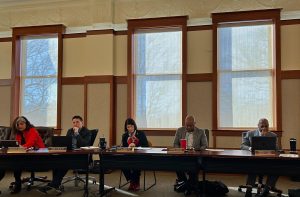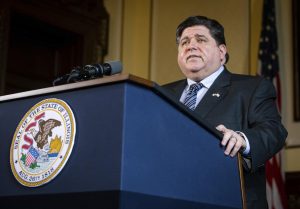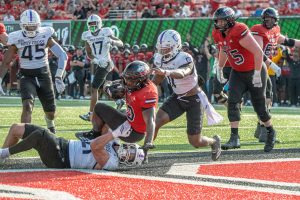Damien Chazelle has yet to disappoint
October 28, 2018
In less than 10 years, Damien Chazelle has directed four films, including the recent Neil Armstrong biopic “First Man,” released Oct. 12, that have cemented him as one of this generation’s greatest minds in film. As the youngest winner of the Academy Award for Best Director, Chazelle has proven his prowess with stunning visuals and compelling stories.
His first film, “Guy and Madeline on a Park Bench,” was released in 2009. The black-and-white jazz musical came to fruition as an idea for Chazelle’s senior thesis while he was a student at Harvard in 2007.
The film tells the story of two lovers as they go through the ups and downs of life. Guy is an aspiring jazz trumpeter and Madeline is an unemployed wanderer, and both of them want all of what life has to offer. The most impressive aspect of the film is the production. According to Box Office Mojo, the film’s budget was $60,000. From the precision of his filmmaking, it appears not a single cent was wasted.
From the musical numbers to the effective use of atmosphere, Chazelle put every ounce of passion into the film by serving as the film’s director, producer, writer, cinematographer and editor. The film was given a limited release after its premiere at the Tribeca Film Festival and was positively received, securing Chazelle’s place as a filmmaker.
Chazelle’s next film “Whiplash,” released in 2014, became one of the most acclaimed films of the year. The film follows aspiring jazz drummer Andrew, played by Miles Teller, who wants to be one of the all-time greats.
When he’s invited to play for revered jazz teacher Terence Fletcher, played by J.K. Simmons, Andrew seizes the opportunity. However, Fletcher is a borderline psychotic perfectionist and pushes Andrew to his breaking point.
The battle of wits between Andrew and Fletcher is the standout of the film and it’s because of the character’s interactions that earned J.K. Simmons the Academy Award for Best Supporting Actor. Fletcher constantly berates and pushes Andrew to his idea of success. This technique, while brutal, works and Andrew becomes a fantastic drummer even drumming until his hands bleed. But it costs Andrew his relationship with his girlfriend and strains his relationship with his family.
The ending of the film is magnificent and shows the relationship between teacher and student. At a jazz festival, Andrew drums in a band led by Fletcher and they perform “Caravan.” But when the song ends, Andrew keeps drumming and drumming like he’s under a spell of his own making. His sweat flies and bounces off the cymbals as his hands bleed. He’s losing himself in the music, and Fletcher guides him through the performance. The student has now become the equal of the master.
After the positive feedback of “Whiplash,” Chazelle made a film that brought life back into a genre long since gone. The original Hollywood musical has been shown many times in the golden age of cinema from “Singin’ in the Rain” to “Meet Me in St. Louis.” However, the genre had faded until the only musical films made were those based on Broadway musicals, many of which are amazing in their own right. In 2016 however, “La La Land” came out and original Hollywood musicals are back in the lime light with “A Star is Born” and “The Greatest Showman” garnering positive reviews and making large sums at the box office.
“La La Land” tells the tale of aspiring actress Mia and jazz pianist Sebastian, played by Emma Stone and Ryan Gosling. Both have big dreams of making it big in the entertainment industry and must make difficult choices to attain their dreams.
The film in many ways feels like a reimagining of “Guy and Madeline on a Park Bench” in terms of the musical style. The musical sequences use tracking shots to follow the characters and use very few cuts in order to make the scene feel as if it was accomplished in one take and make it feel more spontaneous. The score is also very jazz based which is fitting for both films since one of the protagonists is a jazz musician.
What distinguishes “La La Land” is its $30 million budget, which allowed Chazelle to make a film that fully displayed the creativity of a musical. From Mia and Sebastian waltzing in the stars at Griffith Observatory to having over a hundred extras dancing on cars in the film’s opening number “Another Day of Sun,” the film contains sequences that only a large budget film could deliver.
The crown jewel of Chazelle’s filmography is his latest film, “First Man” which details the life of American hero Neil Armstrong, played by Ryan Gosling, and the formation of the fateful Apollo 11 mission. While other space exploration films like “Apollo 13” and “2001: A Space Odyssey” have the majority of the film in space, most of “First Man’s” plot takes place on Earth where it builds up the dangers the astronauts faced.
The best example of this build up is at the very beginning when Neil is piloting a jet that bounces of the atmosphere. Seeing him try to get back to the ground and not die makes the viewer terrified for him, which is impressive, because nearly every American knows that Armstrong made it to the Moon and came back to Earth alive.
Neil’s relationship with his wife Janet, played by Claire Foy, is very raw as Janet must deal with the fact that every day Neil goes to work at NASA, there’s a chance he may not come back. That kind of tension comes out the night before Neil leaves for the Apollo 11 mission where Janet demands that Neil explain to their two sons that he may not come home. The monologue that she delivers is very compelling and deserves an award.
When the space sequences are shown, it’s amazing to view. The most powerful moment in the entire film is when the Apollo 11 spacecraft is shown as a small object traveling though the black of space. Every moment that leads up to the lunar landing is suspenseful as the audience is waiting for Neil to say, “The eagle has landed.”
All four of these films have aspects that connect them besides Chazelle, and one is composer Justin Hurwitz. Hurwitz and Chazelle were both roommates at Harvard, and their professional partnership began with “Guy and Madeline on a Park Bench.” Since then, Hurwitz has been providing magnificent music to Chazelle’s films and won the Academy Award for Best Original Score and Best Original Song for his work on “La La Land.”
Another is how human Chazelle makes his characters. These are people who have to face the pressures of their lives. One great example is in “First Man” when Neil suffers a tragic loss. He tries to keep his emotions to himself for the sake of his family but when he’s alone he breaks down crying. It’s not glamourized, but rather portrayed as realistically as possible. The same can be said for “Whiplash.” When Andrew finishes his solo thanks to Fletcher’s directions, they exchange a look. This look says much more about their relationship as student and teacher than any line of dialogue ever could.
In just four films released in less than ten years, Damien Chazelle is one of the most fantastic directors working today. He is a man who understands atmosphere, character and, most of all, how to tell a compelling story. If his next films are half as good as “First Man” or “Whiplash,” then the world of film is truly blessed.






